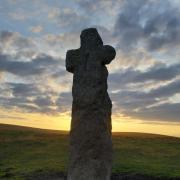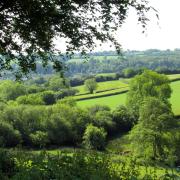A still, windless morning in Silverton. Winter storms have been and gone; now all is quiet on the large open space that graces the village: the Big Rec.
In the Rec’s top corner, overlooking the village, the school, the church and surrounding countryside, stands the magnificent Broad Oak, emblem of our village, beloved by countless generations of Silvertonians. Thus she has stood for hundreds of years, growing, spreading, shading, shedding as centuries of seasons passed through her branches. Arboreal watcher of our village; living and iconic soul of our community. A tree to meet under. A tree to hug.
Slowly, imperceptibly, a tiny movement. So small at first it was barely visible. But the movement grew and those who bore witness could see but couldn’t believe. Gathering momentum, cleaving the air with her branches, Broad Oak began to tip, crashing through stillness in a thunderous chaos of twigs and branches, thudding to the ground in an immensity of sound and splintered wood. Then silence. Disbelief. Something in the region of seven hundred years of living history had just come to an end.It is difficult to describe the collective grief of a community that has just lost the ancient tree that symbolises the village. Simply writing this is emotional. I had only known our oak for 30-odd years. For villagers whose families stretch back through the centuries alongside Broad Oak, the sense of loss and bereavement is unspeakable. Tears flowed. People choked up. The twenty-fifth of January was a dreadful day in Silverton.

Broad Oak was a veteran of gigantic proportions. A few years ago I measured her girth at chest height and from this measurement the Ancient Tree Forum suggested an estimated age of 700 years. Without felling the tree, we couldn’t be certain. Now we find ourselves in the desperately sad position of being able to find out.
So let’s assume 700 years. Edward ll was on the throne. The Wars of the Roses was more than 100 years into the future. Henry Vlll had yet to reign. Broad Oak, in her corner of Devon, bore witness over centuries to a changing world: The Peasants’ Revolt, Christopher Columbus reaching the Americas, England’s spell as a Republic, the Industrial Revolution, the construction of the Houses of Parliament, the First and Second World Wars, Neil Armstrong walking on the moon. Throughout it all, Broad Oak stood.
And now she stands no more.

It’s not just the human history. An unimaginable number of birds, mammals, invertebrates, fungi, lichen have called Broad Oak home – a single veteran oak can host a sublime richness of biodiversity, supporting a staggering 2,300 species. To watch clouds of little birds fluttering around her fallen branches as she lay on the Rec was another deep sadness.
But something good must come. And it is a tribute to the cohesive community of Silverton that creative and knowledgeable plans are afoot. Facilitated by our hardworking parish council, the first brain-storming session threw up many wonderful ideas. The area has been made safe and Broad Oak’s trunk will be left in situ as a memorial and dead-wood habitat. Her immediate environs will be left to see what regenerates – potential offspring may be lying dormant and to these can be added potted saplings already dotted around village gardens.

So many creative suggestions: dendrochronology ‘slabs’ of Broad Oak with timelines, nesting boxes, benches, cleft-wood arches, a children’s climbing frame…. over the ensuing months I feel certain that more ideas will flow.
Seven hundred years of history has just come to an end. Or has it? No. Broad Oak will live on in many different forms.
The next 700 years is just about to start.



























